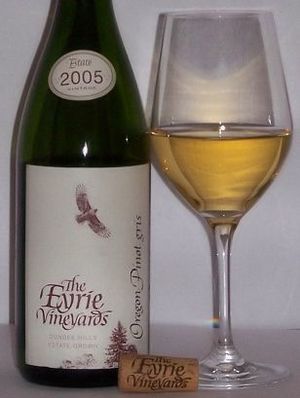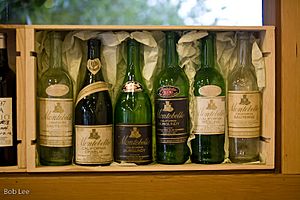Wine of the United States facts for kids
Wine has been made in the United States for a very long time, starting in the 1500s. The first big production began in New Mexico in 1628. Today, wine is made in all 50 states! California makes most of it, about 84% of all US wine.
North America has many types of native grapes, like Vitis labrusca and Vitis riparia. But the wine industry mainly uses a European grape called Vitis vinifera. European settlers brought this grape to America. The United States is the fourth-largest wine-producing country in the world, after Italy, Spain, and France. It has over 1,100,000 acres (4,500 km2) of grapevines.
Contents
History of US Wine
The first Europeans to explore North America were Vikings from Greenland. They called the land Vinland because they found so many grapevines. The earliest wine in what is now the United States was made by French settlers in Florida around 1562-1564. They used local Scuppernong grapes.
In the early American colonies like Virginia and the Carolinas, making wine was an important goal. However, settlers found that wine made from native grapes tasted different from what they were used to. They often did not like it.
This led to many tries to grow the familiar European Vitis vinifera grapes. In 1619, the Virginia Company brought French grapevines and winemakers to Virginia. But these early plantings failed because native pests and grapevine diseases destroyed the vineyards.
In the Southwest, Spanish missions in California and Santa Fe de Nuevo México planted vineyards. These traditions still exist in the modern California and New Mexico wine industries. New Mexico wine started in 1629, making it the oldest wine region in the US. Mission grapes were grown for California wine by 1680. In 1683, William Penn planted French grapevines in Pennsylvania.
One of the first commercial wineries in the US was started in 1787 by Pierre Legaux in Pennsylvania. Today, special hybrid grapes (a mix of French and American grapes) are common for wine production on the East Coast of the United States.
In 1799, the state of Kentucky decided to create a commercial vineyard and winery. A winemaker from Switzerland, John James Dufour, started "First Vineyard" in Jessamine County. The first wine from this vineyard was enjoyed in 1803. In 1805, two barrels of this wine were even sent to President Thomas Jefferson! The vineyard continued until 1809, when a bad freeze destroyed the grapes.
In California, the first major vineyard was started in 1769 by a missionary named Junípero Serra near San Diego. Later, missionaries carried grapevines northward. California has two native grape types, but they don't make good wine. The missionaries used the Mission grape, which is a Vitis vinifera type but makes "very modest" quality wine.
The first winery in the United States to become truly successful was founded in Cincinnati, Ohio, in the 1830s by Nicholas Longworth. He made a sparkling wine from Catawba grapes. By 1855, Ohio had many acres of vineyards.
In the 1860s, vineyards in the Ohio River Valley faced a disease called Black rot. This made some winemakers move north to the Finger Lakes region of New York. At the same time, the Missouri wine industry grew quickly. By the end of the 1800s, Missouri was second only to California in wine production. Later, a tiny insect called phylloxera and another disease called Pierce's disease badly damaged the American wine industry.
A time called Prohibition began in the United States in 1920. This law made it illegal to make, sell, or transport alcohol. Some exceptions were made for sacramental wine used for religious purposes. Because of this, many vineyards stopped working. In New Mexico, monks and nuns were able to keep their old wine grape types alive for religious uses. People also started making wine at home, which was allowed for personal or religious use.
After Prohibition ended in 1933, people tried to restart the American wine industry. It was very difficult because many skilled winemakers had left or died. Vineyards were also in bad shape. People's tastes in wine had changed too. They wanted cheap, sweet wines. For many decades, wine production stayed low.
New ways of making wine were developed thanks to research at the University of California, Davis, and other universities in New York. Experts taught about which grapes grew best where, shared winemaking tips, and helped grape growers. In the 1970s and 1980s, California winemakers became very successful. This brought money from other wine regions, like France. Winemakers also started vineyards in Oregon, Washington, and other new places.
Americans learned more about wines and wanted better quality. Now, all 50 states have some vineyards. Today, the US makes over 800 million gallons of wine a year. California makes over 84%, followed by Washington, New York, Pennsylvania, and Oregon.
Where Wine is Made in the US
There are almost 3,000 commercial vineyards in the United States. Every single state has at least one winery!
Here are the main wine-making regions:
- West Coast: More than 90% of American wine comes from California, Washington, and Oregon.
- Southwestern United States: This includes New Mexico and Arizona.
- Rocky Mountain Region: Such as Idaho and Colorado.
- Southern United States: Like Texas, Kentucky, Tennessee, Georgia, and Alabama.
- Midwestern United States: Including Missouri and Illinois.
- Great Lakes region: Such as Michigan, New York, and Ohio.
- East Coast of the United States: This includes eastern Long Island in New York, New Jersey, Pennsylvania, Virginia, North Carolina, and Florida.
Wine Labeling Rules
The United States has a system for naming wine regions called American Viticultural Areas (AVAs). These areas are special because of their unique climate and geography. In 1980, the Augusta AVA in Missouri was the first AVA created.
What Labels Must Say
For a wine label to show an AVA name, at least 85% of the grapes used to make the wine must come from that AVA.
If a label shows a state or county name, 75% of the grapes must be from that state or county. Some states have even stricter rules. For example, California requires 100% of the grapes to be from California if the wine is labeled "California." Washington state requires 95% of the grapes to be from Washington.
A wine labeled "American wine" or "United States" can be made from grapes grown anywhere in the US. These wines are usually for bulk export and cannot have a specific year (vintage) on the label.
In the past, US laws allowed American wines to use names like "American Burgundy" or "California champagne." These names are protected in Europe, meaning only wines from those specific regions can use them. US laws required that the label also include the American place, like "California champagne." This practice mostly stopped in 2006, but some older brands can still do it.
Other Labeling Rules
If a bottle is named after a specific type of grape (like pinot noir), at least 75% of the grapes must be that type. In Oregon, this rule is 90% for some grapes.
For a specific year (vintage) to be on the label, at least 95% of the wine must be from grapes harvested in that year.
All wine labels must also list the alcohol content. They must also say that the wine contains sulfites and include a warning from the Surgeon General about alcohol consumption.
How Wine is Sold
After Prohibition ended, the US government let each state make its own rules for selling alcohol. Most states created a "three-tier" system. This means wine goes from the producer (winery) to a wholesaler, and then to a store or restaurant, and finally to the customer.
Some states allow wineries to sell directly to customers at the winery or ship wine across state lines. Some states also allow online sales.
Biggest Wine Makers
As of 2016, these are some of the largest wine producers in the US:
- E & J Gallo Winery
- The Wine Group
- Constellation Brands
- Trinchero Family Estates
- Treasury Wine Estates
- Bronco Wine Company
- Delicato Family Wines
- Ste. Michelle Wine Estates
- Jackson Family Wines
- Concha y Toro
See also
 In Spanish: Vino de Estados Unidos para niños
In Spanish: Vino de Estados Unidos para niños



